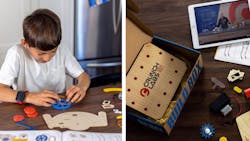Happy Holidays: Wacky DIY Project Kits Develop Creativity and Problem-Solving Skills
Check out more galleries and articles in Holiday Gifts for Engineers of All Ages.
This gallery appeared in Electronic Design and has been published here with permission.
I dare you to watch CrunchLabs' video about its Build Box project kits and not crack a smile. Unlike so many "educational" STEM toys, this series of "fun-forward" DIY games and projects stealthily introduce important problem-solving skills without giving off even a hint of "good-for-you" vibes that might spoil the fun. Although I haven't laid hands on a Build Box (yet), I'm pretty sure it will be a hit for both nerds and non-nerds alike.
The Build Box kits are offered as a monthly subscription series (2, 4, 6, or 12 kits @$24.95-$29.95/month), with each kit containing an original, buildable engineering toy and a highly entertaining (and science-packed) video. Mark Rober, CrunchLabs' self-appointed Head Nerd & former NASA engineer, describes these kits as part of a massive, Willy Wonka-style factory of creativity that helps kids (and kids at heart) develop their creative powers and "learn to think like an engineer."
CrunchLabs Build Boxes are designed for kids ages 8-12+, but they appear to be clever enough that adults will actually enjoy playing alongside their kids. I wish these had been around when I was a kid, but look forward to sharing them with several nieces and nephews.
To order, or learn more, visit https://www.crunchlabs.com/.
More Geek Fun
If you’re looking for another present for the budding genius in your life, consider the Spintronics learning lab that won last year's Geek Gift of the Year award. It combines hands-on experiments with mechanical analogs of electrical components, plus a graphic novel and an engaging online role-playing game.
About the Author
Lee Goldberg
Contributing Editor
Lee Goldberg is a self-identified “Recovering Engineer,” Maker/Hacker, Green-Tech Maven, Aviator, Gadfly, and Geek Dad. He spent the first 18 years of his career helping design microprocessors, embedded systems, renewable energy applications, and the occasional interplanetary spacecraft. After trading his ‘scope and soldering iron for a keyboard and a second career as a tech journalist, he’s spent the next two decades at several print and online engineering publications.
Lee’s current focus is power electronics, especially the technologies involved with energy efficiency, energy management, and renewable energy. This dovetails with his coverage of sustainable technologies and various environmental and social issues within the engineering community that he began in 1996. Lee also covers 3D printers, open-source hardware, and other Maker/Hacker technologies.
Lee holds a BSEE in Electrical Engineering from Thomas Edison College, and participated in a colloquium on technology, society, and the environment at Goddard College’s Institute for Social Ecology. His book, “Green Electronics/Green Bottom Line - A Commonsense Guide To Environmentally Responsible Engineering and Management,” was published by Newnes Press.
Lee, his wife Catherine, and his daughter Anwyn currently reside in the outskirts of Princeton N.J., where they masquerade as a typical suburban family.

